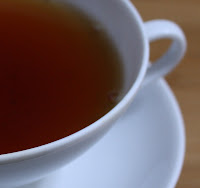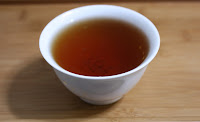 Tea: Hojicha
Tea: HojichaVendor: Wegmans Food Markets / Ito En
Price: $48.99 / lb
Vendor description: Crafted from roasted green tea, hojicha offers a visually stimulating medley of stem and leaf. Young grassy notes mingle with a taste that is effusive and toasty. It is an ideal tea for relaxing and appealing for its low caffeine content.
Leaf: This hojicha has a very evenly colored leaf. It has a brown hue with hints of green to it. There is a lightly dusty aroma to it, this is somewhat different in comparison to the normal roasted aroma of a hojicha. There is also a high leaf to stem ratio for this hojicha making it more akin to a kukicha hojicha, but not fully there.
1st Infusion Parameters: 5g, 5oz, 208F, 2 min
 1st Infusion: The hojicha exhibits a very traditional brown hue. The aroma is very odd. It does not have the normal roasted aspects of a hojicha. It is duller and light. The flavor is also not terribly traditional. It is light, yet full bodied. It is smooth and rolls down the back of the tongue. The actual strength of the flavor isn't very noticeable, instead it is dominated by the texture, just not so much flavor. What flavor there is, is lightly burnt/roasted, but it is just hints.
1st Infusion: The hojicha exhibits a very traditional brown hue. The aroma is very odd. It does not have the normal roasted aspects of a hojicha. It is duller and light. The flavor is also not terribly traditional. It is light, yet full bodied. It is smooth and rolls down the back of the tongue. The actual strength of the flavor isn't very noticeable, instead it is dominated by the texture, just not so much flavor. What flavor there is, is lightly burnt/roasted, but it is just hints.2nd Infusion Parameters: 208F, 3 min
2nd Infusion: This infusion is more golden borwn in color. The aroma is more traditional and smells of roasting. The flavor still feels light and empty though. You feel the texture of the tea on the sides of your mouth, but the core flavor is lacking.
Rating: 3 / 10
Conclusion: This tea felt like it was missing a single part of the flavor, unfortunately that was the central core of the flavor. If that was present, it would be much better. Without that component though it felt empty and bland.





































